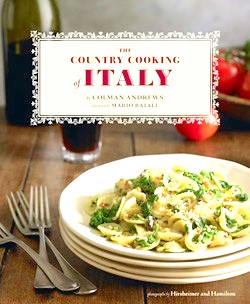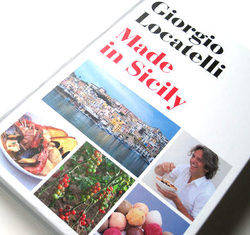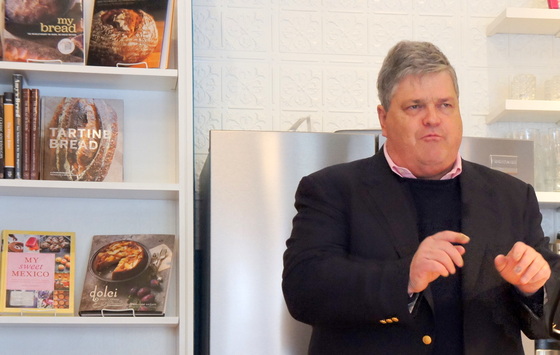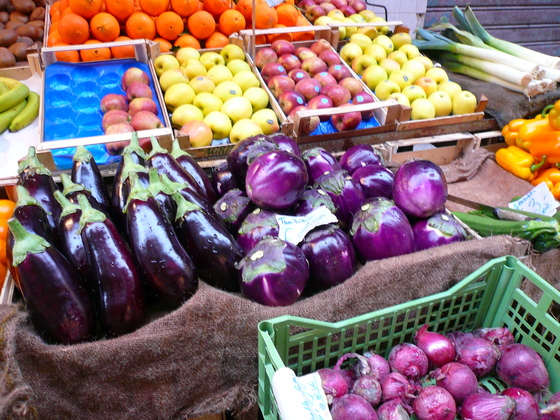Cookbook author Colman Andrews speaking at Book Larder in Seattle
 It's sometimes said that if you're not a native of Sicily (or Provence, or New Orleans), you can't possibly cook authentic caponata (or ratatouille or étouffée). How true is that?
It's sometimes said that if you're not a native of Sicily (or Provence, or New Orleans), you can't possibly cook authentic caponata (or ratatouille or étouffée). How true is that?
Food is critical to culture, to be sure, and today's food culture is putting great emphasis on eating what's local. But "locavores" who limit their sustenance to food that comes from their own backyard are making a cultural and culinary mistake: civilization, Colman Andrews points out, is based on trade, on moving stuff from one place to another. Salt from the Mediterranean was shipped to Scandinavia, where it was used to preserve cod, that was shipped back to the Mediterranean. Cooks in Liguria used the ubiquitous basil plants only to make pesto, nothing else. And even within a region, minor distances (two towns over) become genuine cultural and culinary gulfs.
If you were to make an "authentic" bouillabaisse, Andrews points out, you'd have to find someone selling rascasse, a spiny Mediterranean fish that might cost $20 a pound in a specialty market. But he thinks it's more important to cook with a spirit of authenticity: bouillabaisse was made, originally, by fishermen using fish they would otherwise throw out as trash.
Sara Jenkins, a writer and chef who owns two Italian restaurants in New York City, wrote an essay in The Atlantic last year arguing that "authenticity" is elusive. "Italians are, of course, passionate about their food culture and ready at all times to chastise a foreigner for not understanding that right combinations or sequences of flavors." But what's considered typically Italian has changed markedly over the years. Tomatoes corn, beans and squash, for example, are not native to Italy. "If we wanted to be really authentic with Italian food," she asks, "shouldn't we do away with all the invasive species?"
Trieste, which lies at the intersection of the Adriatic and the Alps, stakes a worthy claim to a varied cuisine honestly come by, since it was the southern port of the Austro-Hungarian Empire. And Sicily, in the center of the Mediterranean, has been colonized by waves of Greeks, Persians, Spaniards, and more, each successive invader planting its seeds and its culinary culture in the island's fertile soil.
Should mention that Andrews runs an annual "101 Best Restaurants" list for Daily Meal. The 2013 list came out today; two Seattle spots, Canlis and Dahlia Lounge, are among the winners.
Eggplant at one of the three public markets in Palermo, Sicily, February 2009.
 Besides, if only Sicilians were allowed to cook Sicilian food, no one would bother writing such great cookbooks. Now, that would be a real scandal. Giorgio Locatelli's ambitious "Made in Sicily" attempts to explain, but misses the mark.
Besides, if only Sicilians were allowed to cook Sicilian food, no one would bother writing such great cookbooks. Now, that would be a real scandal. Giorgio Locatelli's ambitious "Made in Sicily" attempts to explain, but misses the mark.
Locatelli is the well-known owner of a popular Italian restaurant, Locanda Locatelli, in London. He grew up in a restaurant family on one of the Alpine lakes in northern Italy and didn't travel to Sicily until he'd been a professional chef in Britain for two decades. He reports that he was "completely blown away" by his visit to this "mythological island." As an amateur food historian, he learns that Sicily's cuisine has been influenced by all its Mediterranean neighbors: Greece, Spain, the Arabs. The rich land and teeming sea provide a wealth of riches; "what grows together goes together."
But this (clumsy) sentence is just plain wrong; "...in most of Italy we have an unwritten rule that you never put fish and cheese together, something that the Sicilians happily do all the time and that works." In fact, the Sicilians are the most vocal defenders of the seafood-dairy barrier. (For those who compulsively drown crab fettuccine in cream, top scallops and prawns with parmesan, and dip lobster claws in melted butter, the culinary concept is to preserve the delicate flavor and aroma of fish; a spritz of lemon is all that perfectly fresh seafood needs. Seriously)
"There is an understanding that you will feed people with whatever you have," Locatelli writes, and since most of Sicily is a vast garden, what you have most abundantly is vegetables, and, because it is an island, there is a greater emphasis on and pride in fish, rather than meat.
But then he contradicts himself. If you don't have any wild mountain fennel, Locatelli says, you can use fennel seeds. Mario Batali would disagree; he coarsely chops some fennel bulb and tosses it with olive oil. Neither is correct. If you don't have wild mountain fennel, you'd be tempted to substitute the bushy green tops of a regular fennel bulb, but it's not quite the same. Some of my Sicilian friends won't make pasta con le sarde unless they have bucatini (hollow spaghetti) and Mediterranean sardines.
The photographs, credited to Lisa Linder, are dark and grainy. There's none of Sicily's sun, none of its optimism. Would it have killed the photographer or the photo editing software to brighten the landscapes by an f/ stop or two? The food closeups, too, could use better styling, better lighting, better color. Linder is a respected photographer for British travel magazines and advertising agencies, but this doesn't appear to be a particularly inspired effort.
It's not until the very end that the reader realizes a serious omission: the section on wine grapes, "compiled" by Locanda's wine director, runs only two pages, with quick descriptions of 11 white and 7 red grape varieties. Fortunately, there's a new book about Sicilian wine by the redoubtable Bill Nesto, MW; review coming up shortly.
Locatelli gives four recipes for Sicily's iconic appetizer, caponata (summer, winter, Christmas and artichoke-based), reminding us yet again that eggplant was introduced to Sicily "by the Arabs." The dish is not unlike the French ratatouille, assembled from sauteed or deep-fried vegetables, though caponata is often made sweeter by the addition of sugar or balsamic vinegar. They all contain eggplant, however.
Finally: "Very little in this book is complicated, because in Sicily the ingredients are so special they speak for themselves. If you have been to Sicily you will understand. If you haven't been to Sicily, then you must go."
Italian Country Cooking by Colman Andrews, Chronicle Books, 392 pages, $45
Made in Sicily, by Giorgio Locatelli with Sheila Keating, Harper Collins, 423 pages, $45


Leave a comment